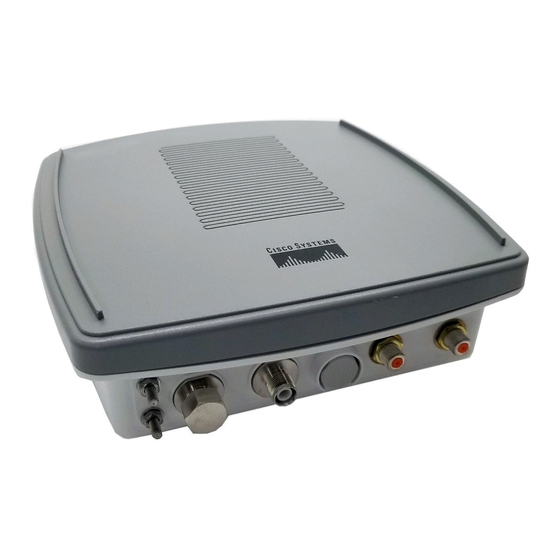Cisco AIR-LAP1310G-A-K9 Datasheet - Page 8
Browse online or download pdf Datasheet for Wireless Access Point Cisco AIR-LAP1310G-A-K9. Cisco AIR-LAP1310G-A-K9 15 pages. Outdoor access point or bridge

Product Specifications
Link Roles and Product Compatibility
Table 1 outlines the link roles in which the Cisco Aironet 1300 Series can operate, and identifies the products that it
is compatible with in the particular role.
Table 1.
Role
Access Point
Bridge
Workgroup
Bridge
Protocols
Table 2 lists the protocols supported by the Cisco Aironet 1300 Series.
Table 2.
Protocols
Air Interface
Standard
Frequency Band
Wireless
Modulation
Media Access
Protocol
Lightweight Access
Point Protocol
Operating Channels 802.11b/g
© 2009 Cisco Systems, Inc. All rights reserved. This document is Cisco Public Information.
Link Role and Product Compatibility
Applications
Engineered specifically for harsh outdoor
environments, yet also capable in indoor deployments,
the Cisco Aironet 1300 Series is ideal for WLANs
requiring outdoor coverage. The Cisco Aironet 1300
Series is Wi-Fi certified as an access point and also
supports the innovative features available with Cisco
Aironet and Cisco Compatible client devices.
The Cisco Aironet 1300 Series supports either point-to-
point or point-to-multipoint configurations to cost-
effectively interconnect remote, temporary, or mobile
networks. It can serve as an upgrade or replacement to
the Cisco Aironet 350 Wireless Bridge by providing
over-the-air compatibility with existing Cisco Aironet
350 Series Wireless Bridges. While in bridge mode,
client associations are also accepted—effectively
providing simultaneous bridge and access-point
capability.
There is no hard/soft limit on the number of devices
you can have, however we only recommend up to a
maximum of 20 devices.
Protocols
Description
IEEE 802.11b or IEEE 802.11g
Note: Autonomous bridge mode has enhancements to the standard to allow longer-range bridging communications.
● 2.412 to 2.462 GHz (FCC)
● 2.412 to 2.472 GHz (ETSI)
● 2.412 to 2.472 GHz (TELEC)
802.11b
● Direct Sequence Spread Spectrum (DSSS):
Differential Binary Phase Shift Keying (DBPSK) at 1 Mbps
◦
Differential Quadrature Phase Shift Keying (DQPSK) at 2 Mbps
◦
Complementary Code Keying (CCK) at 5.5 and 11 Mbps
◦
802.11g
● Orthogonal Frequency Divisional Multiplexing (OFDM):
BPSK at 6 and 9 Mbps
◦
QPSK at 12 and 18 Mbps
◦
16-quadrature amplitude modulation (QAM) at 24 and 36 Mbps
◦
64-QAM at 48 and 54 Mbps
◦
Carrier-Sense Multiple Access with Collision Avoidance (CSMA/CA)
A network protocol for lightweight access points that also provides for centralized management.
● ETSI: 13
● Americas: 11
● TELEC (Japan): 13
Unified or
Compatibility
Autonomous
Architecture
● Compatible with any Wi-Fi certified WPA or
Unified or
Autonomous
WPA2 client device for basic capability
● Compatible with Cisco Aironet clients and
Cisco Compatible clients for extended
capability
Autonomous
Compatible with Cisco Aironet 1300 Series and
350 Series Wireless Bridges
Autonomous
Supports operation with Cisco Aironet access
points and Cisco bridges
Data Sheet
Page 8 of 14
